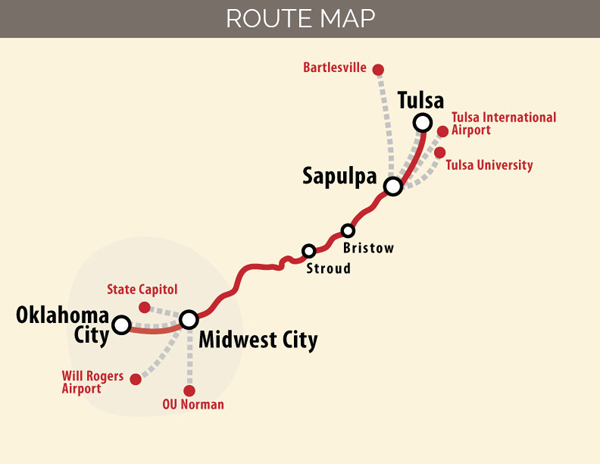Happening Now
Get Involved in Restoring Passenger Rail Between Oklahoma City and Tulsa!
February 28, 2014
Written By Sean Jeans Gail

Image courtesy Easternflyer.com
May 14, 1967 marked the last passenger train service between Oklahoma City and Tulsa, with the last run of the Frisco's Oklahoman. Four years later saw passenger train leave Tulsa entirely, when the Santa Fe's Tulsan was discontinued on May 1, 1971.
Today, we have the power to change that.
Oklahoma’s Transportation Commission is deliberating on the future of the Sooner Subdivision, a 97 mile rail corridor between Oklahoma City and Tulsa, and communities along the line are fighting to protect the right to develop a connecting passenger service. As NARP reported earlier, the Oklahoma City Council passed a resolution requesting that the state retain ownership of the railroad by a 9 to 0 vote. A nearly identical resolution was adopted by the city of Tulsa, the city of Sapulpa, and the city of Bristow this month. All were passed unanimously.
If that’s not a strong enough statement of endorsement, when Iowa Pacific ran three demonstration trains this month, they drew a crowd of over 900 passengers, selling out all three runs. The demand is there. The question is: will leaders in Oklahoma step up make the necessary investments?
Next Steps by the State
That question will be answered in large part by Oklahoma’s Transportation Commission.
The state bought the rail line from BNSF in 1998 for the purpose of preserving it for local shippers, while preserving the option to develop passenger rail service. The Stillwater shortline railroad took over operations and revitalized the line, which has grown steadily. Oklahoma receives 10 percent of gross revenues, which equaled $591,000 in 2013 alone. Right now, the Oklahoma Department of Commerce is conducting an economic impact and activity study to evaluate potential effects of the sale of the Sooner Subdivision.
Concurrently, five department heads at Oklahoman agencies—the Secretaries of Transportation, Finance, Commerce, Agriculture, and Energy—will have 90 days to prepare a recommendation to the Transportation Commission based on their review of the economic impact study.
At that point the Transportation Commission will make its decision.
What You Can Do
NARP has written to Governor Mary Fallin, along with the five department heads, to explain the potential benefits of this service. We've also notified local media about this month's important developments.
If you’re looking to get involved, you can call Governor Fallin (405-521-2342) and tell her that:
- The state needs to keep its promise to Oklahoma citizens that the rail corridor between Oklahoma City and Tulsa will be preserved for future passenger use.
- This means strengthening the language in the Sooner Subdivision to allow a passenger operator reasonable and direct access to run service at tracks speeds that would allow for a two hour terminal-to-terminal run.
- The three sold out test runs for Iowa Pacific’s Eastern Flyer prove that the demand is there for this service.
Encourage Governor Fallin to listen to the communities along the route who are fighting to preserve their right to mobility. The solution is within reach!
"When [NARP] comes to Washington, you help embolden us in our efforts to continue the progress for passenger rail. And not just on the Northeast Corridor. All over America! High-speed rail, passenger rail is coming to America, thanks to a lot of your efforts! We’re partners in this. ... You are the ones that are going to make this happen. Do not be dissuaded by the naysayers. There are thousands of people all over America who are for passenger rail and you represent the best of what America is about!"
Secretary Ray LaHood, U.S. Department of Transportation
2012 NARP Spring Council Meeting
Comments